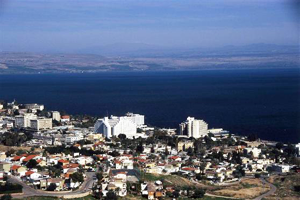
The city on the western shores of the Sea of Galilee. Built between 17-20 AD by Herod Antipas, it was named in honour of Emperor Tiberius (14-37). It became the capital of Antipas' realm in place of Sepphoris.
Open Map ☰
Tiberias is mentioned only once in the New Testament (Jn 6:23) though the adjacent lake, referred to by association as "the Sea of Tiberias" is mentioned twice (Jn 6:1 & 21:1). Though a vital city in the neighbourhood of Capernaum and Bethsaida where Jesus and the disciples lived, it did not feature in any way at all in their recorded lives and ministry.
Because cemeteries were unearthed within its confines during its construction, Jews were at first reluctant to take up residence there. Antipas was forced to settle the city with a mix of Jews and Gentiles. By the middle of 1stCent, however, Jews formed a majority of the population. The city did not resist the Romans in the First Jewish Revolt (66-73), refused to participate in the Second Revolt (132-5), and survived to become the seat of the Sanhedrin, as well as a vital centre of Jewish rabbinical scholarship for many centuries afterwards. It was here that the Jerusalem Talmud was compiled.

Modern Tiberias, looking towards the north.

Further Reading & Resources:
Craig R. Koester, "Topography and Theology in the Gospel of John," In Fortunate the Eyes That See: Essays in Honor of David Noel Freedman in Celebration of His Seventieth Birthday, edited by Astrid B Beck, 436–48. Grand Rapids: Eerdmans, 1995. See p.443-6 ("IV. Tiberias in Galilee") Pdf N 6

©ALBERITH
u081121lch